Mercedes safety

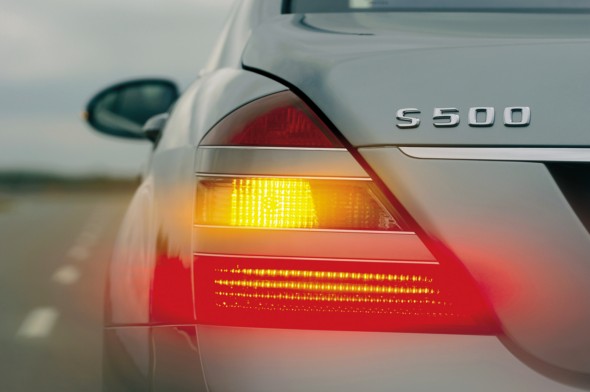
S as in Showcase for Safety
For decades, the Mercedes-Benz S-Class has epitomized automotive luxury, comfort and safety. And this tradition is being continued by the latest version of this elite vehicle family, which made its premiere at the IAA Motor Show in Frankfurt in September.
Hundreds of thousands of visitors to the auto show had the opportunity to see for themselves the impressive breakthroughs Mercedes-Benz engineers have achieved with the new S-Class. Along with more powerful engines — which are nonetheless more fuel-efficient and produce fewer emissions — this elegant sedan offers considerably more room for the occupants and their luggage. It is also equipped with a range of innovative safety features employing state-of-the-art technology. Some of these systems are in fact automotive milestones not found in any other production vehicle in the world.
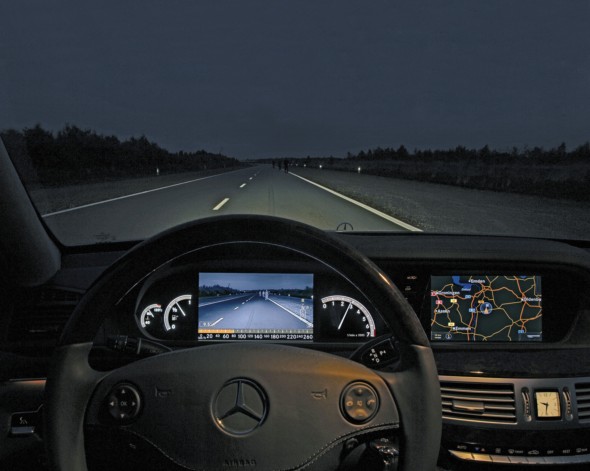
S as in seeing more
Nobody really likes driving at night — and with very good reason: About 40 percent of all fatal traffic accidents in Germany take place at night, although only 15 percent of the total average traffic volume is on the road at this time. And in the United States, the share of accidents occurring at night is nearly 50 percent. Although there are several reasons for this disproportionately high level of risk at night, accident researchers estimate that half of all traffic accidents at night are caused by drivers’ limited visibility.
That was reason enough for the designers of the S-Class to address the issue of night driving. Thanks to bi-xenon headlights, the Active Light System and cornering lights, the new S-Class is now equipped with one of the most powerful and effective light technology packages for automobiles. And customers who choose the Night View Assist option also benefit from headlights equipped with two infrared units, which illuminate the darkness with light that’s invisible to the naked eye.
What sounds like a paradox becomes quite clear during a nighttime test drive conducted at Germany’s Hockenheimring race track. The purpose of the test is to take a close look at the performance of Night View Assist. This calls for sending the S-Class down the track at a speed of 70 kilometers per hour. The powerful low beams in the bi-xenon headlight units light up the road 60 to 70 meters ahead. Suddenly, the driver’s visibility is reduced somewhat by the beam from the headlights of a vehicle traveling in the opposite direction.
Precisely at this moment, and still completely outside the driver’s field of vision, two pedestrians walk onto the edge of the road about 50 meters behind the approaching car.
A glance at the instrument cluster at this point shows two silhouettes that seem to be emerging out of the darkness. The display appears in the area that normally houses the speedometer dial, which is reduced to a horizontal bar display at the lower part of the screen when Night View Assist is activated. The Night View display provides a high-contrast black-and-white image that is an illuminated depiction of the scene in front of the vehicle.
Eye contact at 150 meters
An infrared camera mounted on the inside of the windshield makes it possible for the driver to see the two pedestrians on the video display from as far away as 150 meters. At this distance (and at the speed the S-Class is traveling), the two people would remain unseen for several more seconds by a driver who’s simply looking through the windshield.
With this system, the camera records the reflections from the light emitted by the infrared headlights. These reflections are generated by any objects in front of the vehicle. The onboard electronic system “translates” the infrared (IR) brightness values into gray values that can easily be seen by the naked eye. These values are then displayed onscreen as a black-and-white image. Unlike high beams, IR headlights don’t blind the drivers of oncoming vehicles. That’s because they emit their light at a wavelength that’s invisible to the human eye.
“It only takes about an hour for drivers to get used to the video image. Then they’re able to use the display in much the same way they look in the rearview and side mirrors,” says Stefan Gleißner of Passenger Car Development, whose responsibilities also included preparing Night View Assist for series production.
During the extensive practical testing conducted on Night View Assist in the new S-Class, developers didn’t only look over the test subjects’ shoulders to see how they used the system; they also asked the subjects afterwards to rate the system’s usefulness. The respondents had only praise for Night View Assist.
Even a bi-xenon headlight’s powerful low beam can only illuminate the area in front of a vehicle up to a distance of 70 meters at most. The infrared unit in Night View Assist, however, doubles this range to 150 meters. This allows the display (bottom) to show the pedestrians, who are still quite far away. Night View Assist is activated using a switch (right) positioned next to the knob for the lights.
Redundant operating concept with switches and the COMAND system
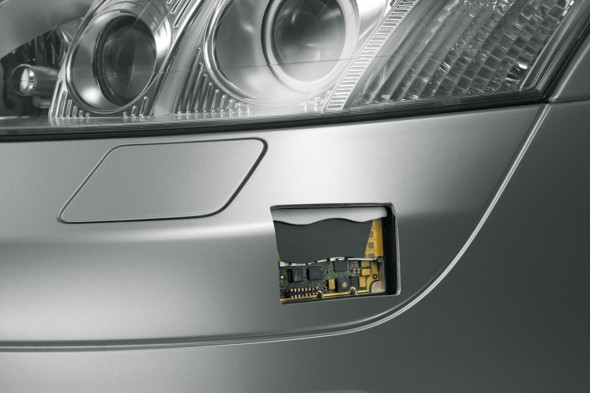
Infrared headlights and a camera for Night View Assist
Radar sensors for DISTRONIC Plus, Brake Assist Plus and the Parking Assistant
Electronic components for PRE-SAFE® with expanded features
Multi-contour seats for maximum comfort and preventive safety
24-GHz radar sensors help with parking and driving in reverse
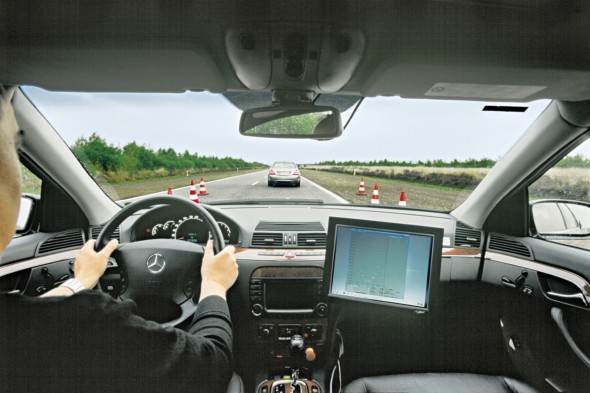
S as in stopping fast
Sensors that not only monitor a vehicle’s surroundings by night or day, but also recognize dangerous situations at lightning speed form the heart of an assistant system available in all new S-Class variants in conjunction with the optional DISTRONIC Plus system (see below). As its name implies, the Brake Assist PLUS assistant system is a new and improved version of its predecessor, Brake Assist (BAS), which went into production in 1996.
BAS is essentially the result of interesting discoveries made by passenger car development engineers during their analyses of accidents. The engineers found that in many cases drivers reacted correctly and quickly enough in critical situations. For example, they tended to step on the brakes hard and fast when impact seemed imminent. However, the researchers also discovered that the drivers often applied too little force. For instance, in the case of an imminent impact, drivers frequently failed to engage the full power of the braking unit. The result was often a collision with the vehicle in front.
BAS prevents this from happening. Its electronic system interprets the rapid pressure applied to the brakes as an attempt to implement an emergency braking maneuver. It then generates maximum braking pressure, regardless of how forcefully the driver actually engages the pedal.

Vigilant radar “eyes”
Brake Assist PLUS uses two radar systems. First, there’s a 77-GHz radar sensor installed beneath the radiator grille. This unit monitors the environment in front of the vehicle at a narrow angle up to a distance of 150 meters and across an area covering up to three lanes. Two additional 24-GHz radar sensors with an 80-degree angle are concealed behind the front bumper, where they monitor the immediate area in front of the vehicle up to a distance of 30 meters.
Both of these radar systems are very good at not only registering objects up ahead but also calculating the distance from these objects and their relative speed.
If the distance between the vehicle and the registered object is so small that there is a real danger of collision, Brake Assist PLUS issues a visual warning on the instrument cluster display and sounds an alarm over the car speakers. While this is happening, the electronic system calculates the braking deceleration necessary to avert the collision. If the driver then hits the brakes, the braking pressure needed to bring the vehicle to a stop before impact is immediately provided automatically. Ensuring that an appropriate braking force is not exceeded gives those driving behind more time to react.
A test conducted on DaimlerChrysler’s driving simulator in Berlin has demonstrated just how effectively BAS PLUS helps to prevent such dangerous situations from resulting in an accident.
During the testing, 100 subjects “drove” a virtual route consisting of highways and secondary roads. The simulator’s all-around projection feature provided the test subjects with a realistic spatial perception of the road ahead. Its various rotational axes also ensured a good simulation of acceleration, deceleration and skidding, giving drivers the feeling that they were actually traveling in a car.
Engineers programmed several critical situations into the test route. For example, in one scenario, test subjects had to approach the tail end of a highway traffic jam at high speed, while another had a virtual vehicle ahead brake suddenly on a secondary road while traveling at 80 kilometers per hour.
All these situations were arranged to ensure that test subjects could only avoid rear-end collisions by initiating emergency braking sufficiently in advance. Those whose virtual vehicles were equipped with only a conventional braking system failed to avoid the accident in 44 percent of the cases. This figure was reduced to 11 percent with BAS PLUS. In other words, the system prevented 75 percent of all virtual crashes.
Mitigating the effects of traffic accidents
Even when drivers whose cars were equipped with BAS PLUS braked too late to prevent an accident, the system’s electronic calculation of the required braking deceleration still successfully reduced the speed at impact to an average of 26 kilometers per hour. At 47 kilometers per hour, the impact speed was nearly twice as high without BAS PLUS.
Bearing in mind that the increase in impact energy in a crash is proportional to the square of the relative speed at the time of impact, it becomes clear just how effectively BAS PLUS can mitigate the effects of an accident. Without it, all vehicle occupants in the simulation would have been exposed to a level of impact energy four times higher than was the case with BAS PLUS. “You can’t achieve this degree of increased protection by installing additional energy-absorbing crash structures into the vehicle body,” says Gleißner.
The Brake Assist PLUS system uses two 24-GHz short-range radar sensors mounted behind the front bumper to continually monitor the distance from the vehicle ahead. If this distance falls below a critical value, the system warns the driver and calculates the braking force needed to stop the vehicle before it hits the car in front. The developers exhaustively tested the system in the lab (right), on test tracks (left and below), in the driving simulator and on the road.
S-Class developers also factored in the drivers approaching from behind: They equipped the vehicle with adaptive brake lights that begin flashing rapidly during emergency braking. Tests have shown that this signal reduces the reaction time of drivers following behind by 0.2 seconds. This may seem insignificant, but it can make a crucial difference, reducing braking distance by 4.4 meters when the vehicle is traveling at 80 km/h and 5.5 meters at a speed of 100 km/h. The latter figure corresponds to the length of a typical sedan.
S as in stress-free stop-and-go traffic
The two radar systems do more than just provide BAS PLUS with its extremely vigilant “eyes”: They also feed data on the traffic situation in front of the vehicle to another assistance system — DISTRONIC Plus.
The DISTRONIC proximity-controlled cruise control system first became available in 1998 in the predecessor model of the new S-Class. This first generation of DISTRONIC is equipped with only a 77-GHz radar sensor that keeps the distance from the vehicle ahead at a value set by the driver. If the distance decreases below that setting, DISTRONIC gradually brakes its vehicle until the set distance is once again reached. The DISTRONIC system can only operate between speeds of 30 and 180 kilometers per hour.
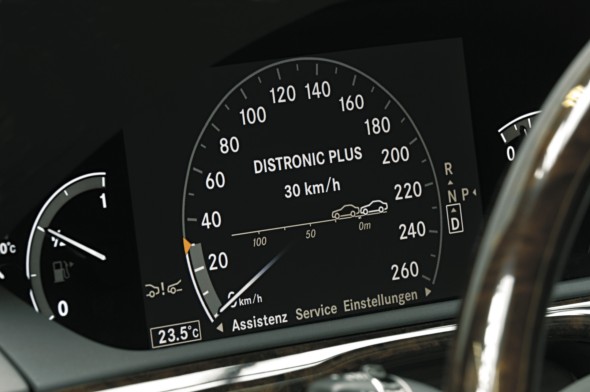
Comfort in stop-and-go traffic
The additional short-range monitoring carried out by the 24-GHz radar sensors has now made it possible to significantly expand DISTRONIC’s operational range. In fact, the DISTRONIC Plus system can now operate between speeds of 0 kilometers per hour and 200 kilometers per hour.
As a consequence, the system can brake the vehicle even in stop-and-go traffic — and will also bring it to a complete stop if necessary.
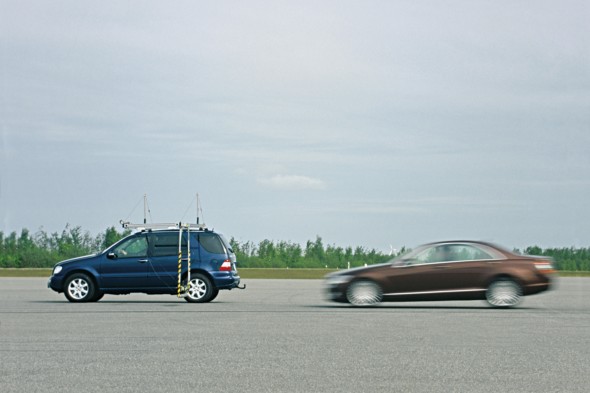
When traffic begins to move again, the driver simply taps the DISTRONIC lever or the gas pedal, and the system is automatically activated again.
Unlike BAS PLUS, DISTRONIC Plus will never decelerate the vehicle using maximum braking force. Instead, the system is designed to decelerate at a maximum rate of four meters per second squared.
If greater braking force is needed in a critical situation, the system will warn the driver visually via the instrument cluster and acoustically through the car speakers. When the driver hits the brakes in response, BAS PLUS ensures that the required braking force is provided.
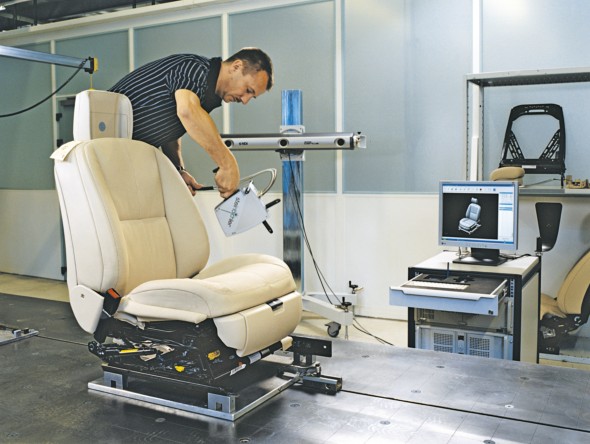
Concealed behind the front bumper (above), 24-GHz radar sensors monitor the area directly in front of the vehicle (green area, left photo). The long-range 77-GHz radar sensor (yellow area, left photo) measures the distance from vehicles ahead up to 150 meters away. This increases the operational range of DISTRONIC plus (the indicator on the instrument cluster, at right), which can now operate between 0 km/h and 200 km/h.
S as in preventive safety measures
T he PRE-SAFE® package, which is now in its second generation, comes with a significantly expanded range of features in the new S-Class. The purpose of this safety system developed by Mercedes-Benz engineers is to ensure that occupant protection features are activated as a precaution before an accident actually occurs. And if a collision really does take place, restraint and protective systems such as seatbelts, belt tensioners and airbags can provide optimal protection against possible injury.
The PRE-SAFE® package, which was introduced in 2002, activates the belt tensioners for all occupants in critical situations that could potentially result in an accident. This means occupants are pulled back as closely as possible to the seat upholstery, ensuring that their upper bodies aren’t shaken back and forth in the event of a collision, a type of movement that can lead to serious injuries. PRE-SAFE® also adjusts the front passenger seat and the individual rear seats in a manner that ensures occupants will not slip under the lower and upper seatbelts in the event of a crash. In addition, if the sunroof is open, PRE-SAFE® closes it to ensure objects from outside don’t fly into the vehicle in the event of a rollover.
Earlier protection possible
The reversible preventive measures in the original PRE-SAFE® package are activated after an analysis of key vehicle data. For example, if the ESP® sensor registers that the vehicle is skidding, or the brake electronics “notice” an emergency braking maneuver, PRE-SAFE® takes action. If the anticipated accident doesn’t occur, the system returns all belts, seats and other equipment to their original settings.
Thanks to the alert Brake Assist PLUS radar sensors in the new S-Class, though, the preventive PRE-SAFE® measures can be activated even earlier, and more effectively. The combination of PRE-SAFE® with the multi-contour seats offered in the new S-Class (see page 38) offers an additional protective effect: Air cushions in the seat bottoms and backs can be inflated within seconds to position an occupant’s upper body up to 40 millimeters farther away from the inner door panels in the event of an impending crash. This allows the sidebag to provide even better protection against injury if the collision actually occurs.
And now, PRE-SAFE® also closes the sunroof and any open windows. Closed windows offer better support for windowbags and also reduce the danger of occupants being thrown from the vehicle, or of objects entering the vehicle from the outside.
Environmental sensors make it possible for PRE-SAFE® to activate its preventive safety measures even sooner.
S as in safe and easy parking
Parking in a tight space and driving in reverse are maneuvers that most drivers would prefer to avoid if at all possible. Driving in reverse is not only uncomfortable;
it also significantly restricts your field of vision. As a result, it’s very easy to simply overlook an object and put a dent in your car.
The Parking Assistant in the S-Class is a big help here. Safe and easy parking is ensured not only
by the two BAS PLUS short-range radar sensors mounted behind the front bumper but also by two additional 24-GHz sensors installed in the rear bumper.
These sensors cover the area behind the vehicle to a distance of up to 11 meters at an 80-degree angle.
At the same time, a split screen view on the instrument cluster’s color display clearly shows the driver just how close the left or right side of the vehicle is getting to other vehicles, poles or other potential obstacles. When the vehicle has moved to within a few centimeters of an object, the system responds by sounding a warning — at first intermittently and then continuously.
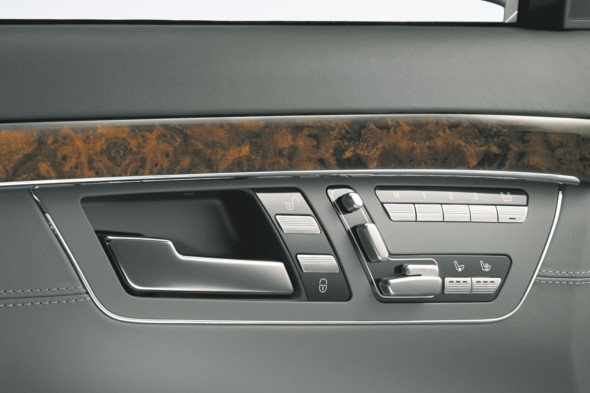
Driving safely in reverse
The radar-based Parking Assistant in the new S-Class has a range of 11 meters behind the vehicle. This means it can cover a much larger area than ultrasound sensor-based systems such as PARKTRONIC, which was used previously.
And this is why the new system also can be used to assist drivers when they have to move longer distances in reverse — for example, when exiting a driveway which isn’t wide enough to allow a U-turn.
The two radar sensors automatically begin to monitor the rear of the vehicle at a speed of seven kilometers per hour and issue acoustic warnings when there is danger of a collision. This allows drivers sufficient time to prevent the collision by applying the brakes.
The radar-based system provides precise parking assistance and protection against collisions when a vehicle is being driven in reverse.
S as in healthy seating
Even in its standard version, the new S-Class is equipped with “12-way” seats that provide great comfort and ensure that occupants and their muscles remain as relaxed as possible, even during long trips. The angle of the seat backs and cushions can be individually adjusted, as can seat height, cushion depth, longitudinal distance and the positions of the headrests. Thanks to the two-way lumbar supports, the driver and the passengers can adjust their seats to conform to the anatomical profiles of their backs.
Switches in the inner door panels are shaped, positioned and marked in a manner that clearly identifies their particular function for the seat, enabling users to adjust settings intuitively. With the help of a memory feature — or the magnetic card that comes with the electronic KEYLESS-GO system — up to three individual settings can be saved per seat. In other words, passengers who change seats can get their personal settings in their new seat just by pushing a button.
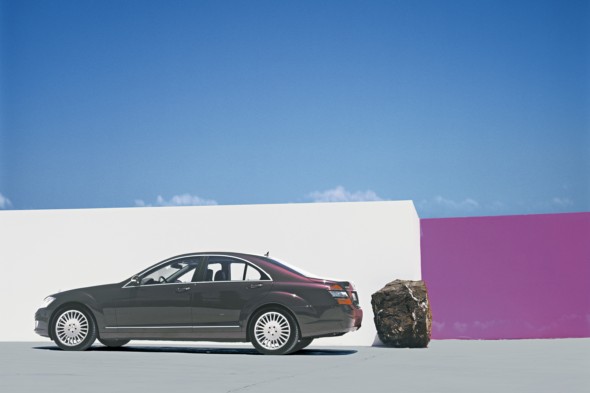
Optional multi-contour seats provide even more comfort and features — with 11 air cushions that allow five different seat areas (ranging from the sides of the seat cushions to the height-adjustable lumbar supports) to be individually adjusted with precise inflation. This means that occupants can now for the first time adjust the firmness of their seats in accordance with their preferences and set the side support to correspond with the driving style of the person who is operating the vehicle.
The PRE-SAFE® electronic system uses fast-reaction piezo valves to control air cushion inflation to provide optimal protection for passengers if a crash appears imminent.
And additional protection is provided by active comfort headrests with adjustable side supports and NECK-PRO technology. The latter works with a precoiled spring that immediately slides the headrests forward and upward in the event of a rear-end collision, a feature that greatly reduces the risk of whiplash for occupants.
Massage feature available
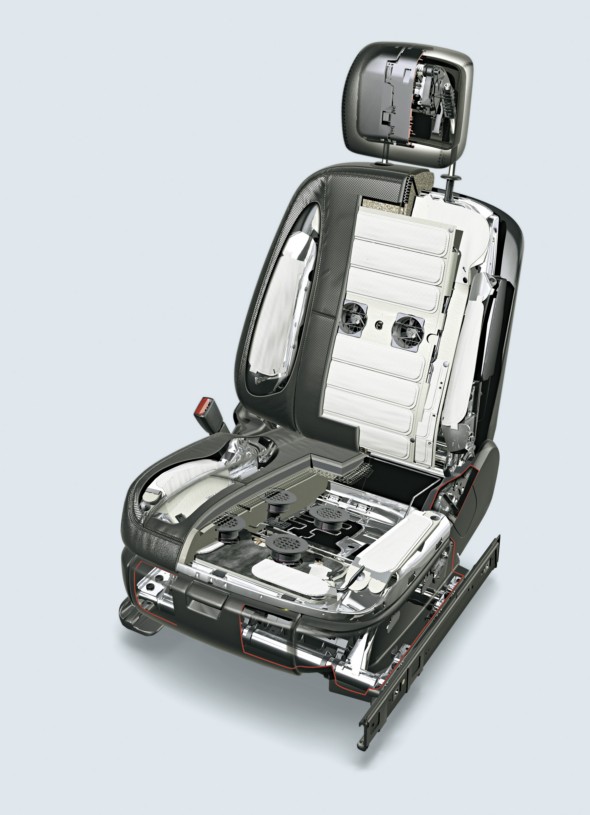
For the first time
The air cushions in the multi-contour seats also provide additional comfort in the form of a completely new massage feature: Seven separate massage air chambers use rapid, electronically controlled inflation and deflation of the air cushions to generate a rolling movement over the occupant’s entire back. The two massage programs available, each of which lasts for five minutes, stimulate the occupant’s muscles in a very pleasant way and improve circulation. In addition to improving the comfort of vehicle occupants, these benefits can also help to prevent fatigue.
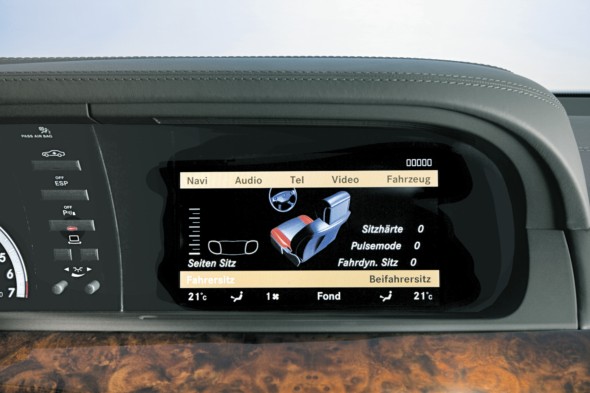
The multi-contour seat (right) not only offers a high level of comfort and adjustability; the quick-reacting piezo valves in the seat’s air chambers are also activated by PRE-SAFE® in critical situations to optimize the effectiveness of the windowbags. The seat and its complex interior were subjected to exhaustive testing at various test beds (two top photos).
Separately controlled air chambers for the massage feature Air cushions controlled by piezo valves
Seat ventilation
S as in systematic operation
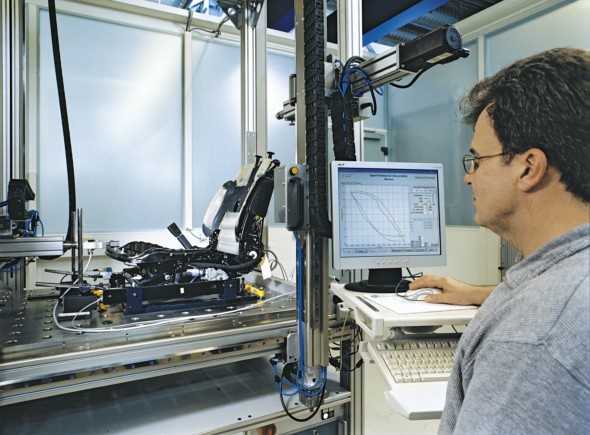
The complexity of operating a car increases in direct correlation with the number of features available and the number of settings each feature has. Or at least that has been the conventional theory up until now.
However, the engineers who developed the new S-Class transcended this conventional wisdom by creating an intelligent operating concept. Although vehicle occupants have an extensive choice when it comes to making adjustments, they nevertheless quickly get used to finding their optimal seating position, selecting music, adjusting the temperature, punching a new destination into the navigation system and activating the various onboard assistance systems.
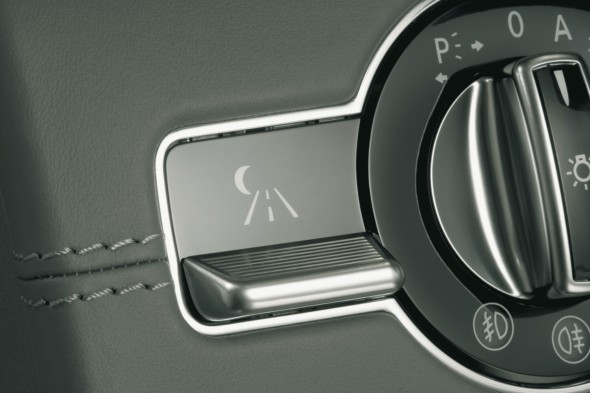
Psychologists and ergonomic experts provided invaluable support to the engineers who were searching for the ideal operating solution. As a result, there is no danger that occupants of the new S-Class will lose their way in a jungle of novel-sized instruction manuals, context-based multi-functional switches and complicated menus.
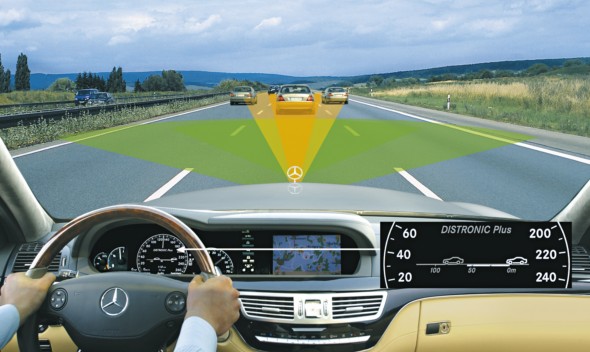
Customized operation
The search for the most suitable means of operation also took another important piece of information into account: Different users prefer different operating concepts. Some people like to use buttons, switches or levers on the stereo or the steering wheel to find or save their favorite radio stations, for example, while others prefer to click through a list of stations presented on a display.
This is why the development engineers made sure occupants in the new S-Class would be able to operate the most frequently used features in accordance with their individual preferences. They did this by installing redundant operating systems. For example, seats can be adjusted either by using switches in the inner door panel or via the color display for the completely redesigned COMAND system. And COMAND’s central navigation button, or Controller, on the center console enables drivers to go through the menu without having to look down.
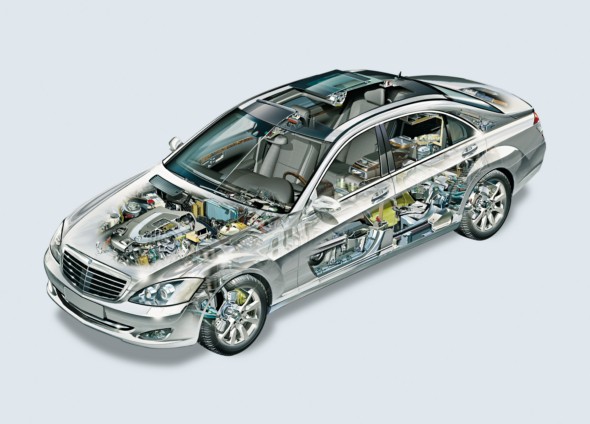
This is possible because the swiveling color display is in full view, right next to the instrument cluster. Running through the menu is very easy — thanks to the realistic graphic display in photo quality, the clear structure of the main menus (up to seven, depending on the equipment options chosen), and a text feature that informs users exactly where they are in the control menu and which settings can be selected.
Frequently used systems, such as the radio, navigation and climate control units, can be operated either via buttons or by running through a menu using the Controller on the center console.
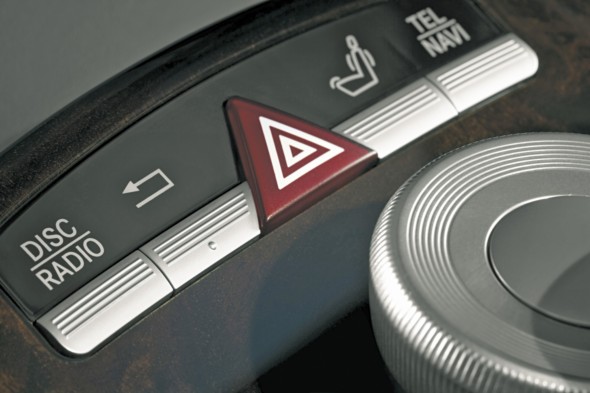
For example, seats can be adjusted by using buttons located on the inner door panel (top image, center) or by operating the COMAND system’s Controller. The system’s display next to the instrument cluster presents the seat setting options as photographic-quality graphic images.
Despite the many adjustment settings and features in the S-Class, its developers have ensured drivers always have a clear overview of all systems.





